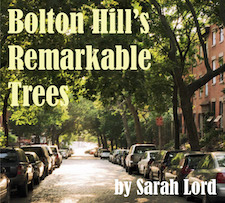 Maples abound in Bolton Hill. In wetter cooler autumns, red maple varieties offer up their pleasing blaze of rouge. The invasive Norway maple is a hardy urban tree, but with duller fall color; it is disliked because it “takes over” and is stingy in benefits to our native wildlife.
Maples abound in Bolton Hill. In wetter cooler autumns, red maple varieties offer up their pleasing blaze of rouge. The invasive Norway maple is a hardy urban tree, but with duller fall color; it is disliked because it “takes over” and is stingy in benefits to our native wildlife.
Also no showboat in the fall, the leaves of the silver maple (Acer saccharinum) turn a pale yellowish. Nonetheless I am very fond of an Acer saccharinum (not to be confused with the universally admired Acer sacchrum – sugar maple) up the alleyways from Johns Street Park. It is two-trunked and massive enough to shade four or five houses from our boiling summer heat.
Nonetheless I am very fond of a neighborhood Acer saccharinum, towering above an alleyway off of John Street Park. It is two-trunked and massive enough to shade four or five houses from our boiling summer heat.
This is a shambling, generous tree, with rough bark and rounded buds and seeds useful to squirrels and birds when other food is scarce. As early as February, it is important to my honeybees trying to make it through winter.
Native Americans used its wood for basket-making and furniture, and its sweet sap for bread-making and in medicine. The Mohegans used an infusion of bark taken from the south-facing side of these trees to make cough medicine.
Then as now, when the wind blows through its foliage, its green leaves ripple, showing their gray undersides. The canopy’s silvery effect is transporting.
